Top News
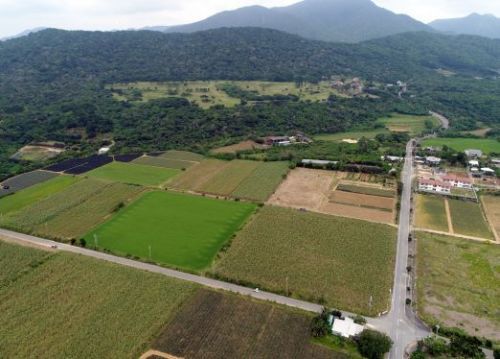
January 17, 2019 Ryukyu Shimpo
By Yuri Shimizu
On January 16, it came to the Ryukyu Shimpo’s attention that on March 1 the Ministry of Defense’s Okinawa Defense Bureau (ODB) plans to begin construction of a Ground Self-Defense Forces (GSDF) post in Ishigaki City, Okinawa, as part of a GSDF deployment plan. In accordance with the Okinawa Prefecture Red Soil Prevention Ordinance, the ODB informed the Okinawa Prefectural Government (OPG) about construction. The ODB notified the OPG that the post is planned to make use of 0.5 hectares of the 46-hectare Hiraeomata, Ishigaki City. It is likely that at least one part of the construction will be started this year as a method of keeping the Okinawa Prefecture Environmental Impact Assessment Ordinance from being applied to the plan, and evading delays to construction.
Collected signatures requesting a public referendum ordinance asking for “yes” or “no” in regard to the deployment plan exceeded the number of signatures required. The push for a public referendum on the matter has been intensifying.
In 2018 the OPG revised the Okinawa Prefecture Environmental Impact Assessment Ordinance and enacted the revision. The revised ordinance applies to plans involving the development of plots of land larger than 20 hectares in size. As a transitional measure, the ordinance does not apply to construction started within fiscal year 2018 (April 1, 2018 through March 31, 2019). Even the shortest assessments take 3 years’ time, so the Japanese government wants to hurry and begin construction within the fiscal year.
According to the OPG, the ODB reported this information to the Okinawa Prefectural Yaeyama Health Care Center in writing on January 4. Construction is set to finish on August 31 this year. According to the Red Soil Prevention Ordinance, if the OPG reviews the assessments and finds anything insufficient, it can demand a discussion with the Japanese government. However, the OPG does not have the authority to grant ministerial approvals and therefore cannot stop construction. The ordinance requires notification of construction 45 days prior to commencement.
Upon receiving notice, Director Hiroshi Ohama of the OPG’s Environment Department said, “I want to strictly examine [these matters].”
Last year in December signatures from about 40 percent of Ishigaki City’s constituents, 14,263 people, were collected to enact a public referendum asking for a “yes” or “no” to the GSDF deployment plan.
The Citizens’ Group for an Ishigaki City Referendum developed the movement for a referendum, and although the group is hoping for a referendum asking for a “yes” or “no” to the plan in February prior to construction commencing, the Ishigaki City Assembly has not begun deliberating on the matter.
(English translation by T&CT and Erin Jones)
Go to Japanese
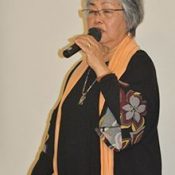
OWAAMV’s Takazato explains WWII-era framework of sexual violence still exists in Okinawa
January 16, 2019 Ryukyu Shimpo
On January 12, a civic public lecture organized by the Battle of Okinawa and Mental Health Research Association titled, “Another Battle of Okinawa—Facing Sexual Violence after the War” was held at the Haebaru Cultural Center in Haebaru Town. A representative of Okinawa Women Act Against Military Violence (OWAAMV), Suzuyo Takazato, and others brought up problems involving comfort women during the battle and sexual offenses related to the concentration of U.S. military bases in Okinawa. Takazato said, “There is prejudice [against Okinawans] among societal leaders and in the training of the U.S. military.” She also mentioned that, “Okinawa is still dangerous.”
Takazato pointed out that there were 145 comfort stations in Okinawa that the Japanese army set up. She said, “It was ‘a new war’ called sexual attacks” of the Japanese army and U.S. army. Sexual violence by the U.S. military began immediately after they landed, and “All residents including men and children were frightened by the violence.” Takazato also scoured records including local municipalities’ histories and newspaper articles, collecting testimonies from victims and sharing them with her audience. She explained that the residents who witnessed sexual assaults also suffered, because they were unable to save those being assaulted.
In regard to the background of continued sexual violence related to the US military bases in Okinawa, Takazato pointed out that prejudice remains deeply rooted in both the U.S. military and in Japanese society. “We must listen to the voices of the victims. We must reveal past sexual violence.” In addition, she appealed for revision of the Japan-U.S. Status of Forces Agreement and stressed that she would not allow the construction of a new base in Henoko, Nago City. Akiko Mori of Doshisha University’s Amami-Okinawa-Ryukyu Research Center of also gave a lecture.
(English translation by T&CT and Megumi Chibana)
Go to Japanese
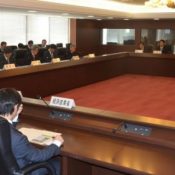
January 18, 2019 Ryukyu Shimpo
Tokyo – The Japanese government held the liaison conference for the governing body for the Convention concerning the Protection of World Cultural and Natural Heritage on January 17, where the confirmed that they would once again nominate, “Amami Oshima, Tokunoshima, the northern region of Okinawa Island, and Iriomote Island,” as a candidate for a World Heritage Site. The conference also will get the cabinet to sign off on January 22, and will submit a formal nomination to the UNESCO World Heritage Centre by the February 1 deadline.
The total land area of the nominated site is 42,698 hectares, a drastic expansion of the previous nomination, which covered 4,752 hectares. The northern region of Okinawa Island accounts for 7,721 hectares of the total land area, up from the previous nominations total of 2,588 hectares; Iriomote accounts for 20,822 hectares, up from 1,987 hectares; Amami Oshima accounts from 11,640 hectares, up from 96 hectares; and Tokunoshima accounts for 2,424 hectares, up from 81 hectares.
Based on the indication of the International Union for Conservation of Nature (IUCN), an advisory board to the World Heritage Committee, factors for the expansion include the addition of the area in the U.S. military’s Northern Training Area (NTA), which was recently returned to Japan, as well as the resolution of the nominated area needing to be as much as possible a small, contiguous area. The criteria has been refined to deal only with biodiversity.
For the remaining area of the NTA, both Japan and the U.S. have specified their comprehensive management plan for cooperation on information sharing as well as dealing with invasive species. Hereafter, each region will develop plans for use of the region for tourism as well as other land-use rules, as well as establish a plan for monitoring endangered species. Akira Shota, head of the Ministry of the Environment’s Natural Environment Agency, said, “I want to will submit the refined nomination along with a detailed field survey and explanation, and get the area added to the list.”
(English traslation by T&CT and Sam Grieb)
Go to Japanese

January 18, 2019 Ryukyu Shimpo Digital Edition
On January 18, multiple sources confirmed Nomura Holdings, Inc. and U.S. investment firm The Carlyle Group are considering the acquisition of Orion Beer.
Nomura and Carlyle are making adjustments with the idea that they acquire the shares of Orion and participate in the company’s management. It is believed they will strengthen shipments to overseas locations, such as Asia, Europe, and America with the cooperation of Carlyle.
(English translation by T&CT and Chelsea Ashimine)
Go to Japanese

January 10, 2019 Ryukyu Shimpo
The black-faced spoonbill, an endangered migratory bird, has migrated to Okinawa for the winter.
On January 9, nine black-faced spoonbills were spotted at what is known as “Triangle Lake” in the Yone area of Tomigusuku City.
The black-faced spoonbill is part of the Threskiornithidae family, and is distinguished by its black, paddle-like beak and appearance of the area around its eyes being connected.
It is found on the Korean peninsula and in China, and spends winters in Southeast Asia and Kyushu and other parts of Japan.
It is designated as an “Threatened 1B” on the Ministry of the Environment’s red list, indicating that it is at high risk of extinction.
A male bird-watcher, aged 60, said he spotted several black-faced spoonbills starting in November of last year.
Their number increased in December, and he spotted 22 of the birds at Lake Man and near Naha Airport.
“The number of birds will increase as it gets colder,” the man said.
(English translation by T&CT and Sandi Aritza)
Go to Japanese
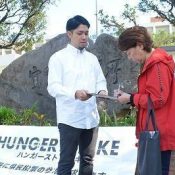
January 15, 2019 Ryukyu Shimpo
Five Okinawan cities are refraining from, or undecided about, participating in the prefectural referendum over the reclamation of land in Henoko, Nago City. In reaction to this news, Henoko Referendum Committee representative, Jinshiro Motoyama launched a hunger strike in front of Ginowan City Hall at 8 a.m. on Jan. 15.
The 27-year-old committee representative will only consume water until the city mayors announce participation in the referendum. Motoyama is also collecting signatures for the cause.
In the morning, Motoyama passed out flyers to solicit understanding from the city hall employees arriving to work. The flyer stated: “The will of 100,000 Okinawan people who signed the petition calling for this referendum should not be ignored. I will protest until the mayor announces the city’s participation in the referendum.”
His new petition is addressed to the five mayors of the cities currently not slated to conduct a referendum ballot. One line read: “Voting rights are the bedrock of democracy. It is unacceptable to allow this lifeline to be taken away.”
The petition may be signed by individuals who reside outside the five cities in question. As for the hunger strike, there are talks about live streaming the efforts online.
Committee Representative Motoyama himself is a Ginowan native. “Every Okinawan has a right to vote. How can politics deny us of that? As a citizen, the fact that I’m disenfranchised is frustrating. I want all Okinawans to vote together,” he said. “In the past, Okinawa has secured rights through staging hunger strikes. I want to do what I can.”
(English translation by T&CT and Monica Shingaki)
Go to Japanese
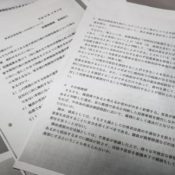
January 14, 2019 Ryukyu Shimpo
Last month in advance of municipal assemblies voting on the supplementary budget for holding a prefectural referendum lawyer and Lower House member Masahisa Miyazaki (LDP) held a study meeting for members of these assemblies.
The referendum concerns Okinawans’ support or opposition of land reclamation work association with the construction of the Futenma Replacement Facility in Henoko.
During the study meeting Miyazaki distributed materials calling for rejection of the budget to hold a prefectural referendum, bearing words such as, “Assembly members bear no legal responsibility in matters such as compensation for damages.” It is likely that Miyazaki’s claims will sway assemblies’ members toward rejection of the budget. Some of these materials obtained by the Ryukyu Shimpo read, “We should call attention to the impropriety of the prefectural referendum, and make our best efforts to reject the draft budget.”
These materials state that should the budget be rejected, “It would be inappropriate and disrespectful to assemblies for a mayor to effectuate the budget despite its rejection in the assembly.”
Miyazaki said in interview with the Ryukyu Shimpo that, “Assembly members sometimes hold study meetings on political matters, through which there are important exchanges of opinions and sharing of information.”
Aforementioned materials that the Ryukyu Shimpo obtained were two documents bearing Miyazaki’s name and dated December 5, 2018, titled, “Regarding a Response to the Ordinance for a Prefectural Referendum.
” The first page lists issues with the prefectural referendum in response to the ordinance. There are six points on this page, some of which are, “There is no consideration or scruntiny being given to removing the danger of Futenma Air Station,” “This only heightens and further entrenches risks,” “Okinawans’ opinions cannot be summarized by the two options ‘yes’ or ‘no’,” and “Information cannot be provided objectively and with neutrality.”
On the second page, the document states that, “It is time to pose a question to the municipal assemblies,” and suggested that assemblies either “1. adopt a written statement opposing the prefectural referendum,” or “2. reject the draft budget necessary to cover administrative work [for the referendum].” The essence of assembly members’ arguments and written statements opposing the draft budget are accordant with Miyazaki’s claims. Furthermore, mayors are refusing to arrange for administrative work for the referendum.
One such document is titled, “Interpreting Local Autonomy Law in accordance with a Response to the Ordinance for a Prefectural Referendum.” This document raised the question, “Is it unthinkable that the methodology of the assemblies could be for us to shelve the budget issue or continue the process to reject it, without devolving into argument?”
(English translation by T&CT and Erin Jones)
Go to Japanese
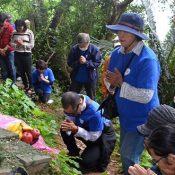
January 13, 2019 Ryukyu Shimpo
The “Life is a treasure! The Ryukyu right of self-determination organization,” a group that is supporting the organization that filed a lawsuit over the return of the remains of people related to the first Sho Dynasty (Ryukoku University Professor Yasukatsu Matsushima, chair), made a pilgrimage to the Mumujana Tomb in Nakijin January 12.
The group was there to report to their ancestor of the lawsuit filed in December of last year, which argues that a professor from Kyoto University removed the remains of the ancestor without permission in the late 1920’s.
There was also a visit to the Nakijin History and Culture Center.
The group raised sticks of incense and placed their hands together in prayer.
There was also a sanshin performance at the nearby Unishi Tomb.
Masako Kameya ,74, one of the descendants of the First House of Sho, said, “We told our ancestor of the suit, and wished, ‘that they look after [the remains].’ I hope that they return the remains from Kyoto University as soon as possible.”
Matsushima, the head of the plaintiff group, commented, “The voices of Okinawa, which demand the return of these remains, are being ignored and discriminated against. This runs through to the new base construction at Henoko as well. Return the remains, and restore the right of self-determination to Ryukyu.”
Part of the remains taken from Mumujana Tomb are also being stored at Taiwan University, who have notified Okinawa of their intention to return the remains.
The “Life is a treasure! The Ryukyu right of self-determination organization,” decided to deliver a written request to Nakijin as well as the Nakijin Board of Education requesting that the remains be reinterred after being returned from Taiwan University.
(English translation by T&CT and Sam Grieb)
Go to Japanese

January 10, 2019 Ryukyu Shimpo
MRO Japan, who operates the aircraft maintenance facility at Naha Airport, began their aircraft maintenance business January 7. On January 9, the company invited various media outlets to come and see the business in operation. They plan on receiving 20 planes for servicing through the end of March.In the future, the company is looking to start receiving aircraft for maintenance from the wider Asian region. The company has plans to hire locally within Okinawa.On January 7, the first day of business, MRO Japan brought into their hangar a DHC8-400 from All Nippon Airways (ANA). The maintenance staff progressed through various tasks that included inspecting the condition of the cables that move the landing gear in and out of the aircraft, and replacing the aeronautical beacons on the tips of the wings.
On January 9, the hangar welcomed a Boeing 373.Maintenance periods can be as short as 3-4 days, but can extend to as long as a month in some cases.There are plans to receive a small aircraft in February for painting, before taking in a larger aircraft in March for the same purpose.MRO Japan relocated to Naha Airport from Itami Airport in Osaka.The company previously serviced around 100 planes each year, and they plan on receiving a similar number of aircraft each year. The majority of the aircraft they have serviced have come from the ANA group.The company plans to take advantage of their prime location in the center of Asia, and moving forward will look to service more planes from countries outside of Japan.
MRO Japan is also looking to hire locally, with the expectation of having 30% of their 230 employees be natives of Okinawa.
Yuta Heianna, 20, who was hired full-time in 2016 after graduating from Okinawa Prefectural Yaeyama Commercial and Technical High School spoke on his aspirations, saying, “Aircraft maintenance is a job where you get to work on aircraft with your own two hands, and I think this is an exciting opportunity for all of Okinawa. I want to work hard so that in the future the job is one Okinawan children dream of someday becoming.”
(English translation by T&CT and Sam Grieb)
Go to Japanese
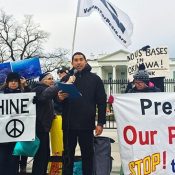
January 9, 2019 Ryukyu Shimpo
By Washington Special Correspondent Yukiyo Zaha
“We are uchinanchu and we don’t give up.” “Base construction is destroying the ecosystem and environment.” “The U.S. is also a concerned party.”
Such calls were resounding at a rally in front of the White House on January 7.
People with roots in Okinawa and veterans with the peace organization Veterans for Peace (VFP) took up microphones and called for suspension of Henoko base construction, which is being forced through by the U.S. government. Another rally by the Ishinda gate to U.S. Camp Foster in Kitanakagusuku Village, Okinawa, was held on the same day in solidarity with the rally in Washington, DC.
Teiko Yonaha-Tursi is a Goodwill Ambassador appointed by the Okinawa prefectural government who resides in New York, and who holds the U.S. and Japan responsible.
She said, “This is a clear example of NIMBY [Not In My Back Yard] from the Japanese mainland.
Enough is enough. The U.S. is also a concerned party.”
Those participating in the rally shouted the words of the former Okinawa governor, the late Takeshi Onaga, toward the White House.
These words were, “Uchinanchu ushetenaibirando (You must not make light of the Okinawan people).”
Robert Kajiwara, who created a petition for the White House to stop land reclamation in Henoko, has sent letters and emails addressing the petition to about 100 governmental officials starting with President Trump and including the members of Congress.
He reiterated his determination to the crowd with the words, “Uchinanchu never give up.”
Frank dela Peña of Veterans for Peace Ryukyu/Okinawa Chapter Kokusai (VFP-ROCK) delivered a greeting for VFP-ROCK representative Douglas Lummis.
He stated, “The base will destroy the coral garden that is Oura Bay, and would drive the endangered dugong mammal from its northmost habitat.
The base would be a source of more pollution, accidents and crimes, especially crimes against women.”
Matthew Jelveh, whose wife is from Okinawa, participated in the rally holding a homemade placard that read “Protect the coral.”
He said, “New base in Henoko is unnecessary. What we can do is not to stay quiet as Americans, as human beings.”
(English translation by T&CT and Erin Jones)
Go to Japanese
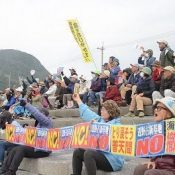
January 9, 2019 Ryukyu Shimpo
Ryukyu Shimpo Digital Edition
On the morning of January 9, the Okinawa Defense Bureau continued depositing sand into the land reclamation area as part of construction of the Futenma Replacement Facility in Henoko, Nago City.
Approximately 120 citizens who oppose construction of the new base protested at Ryukyu Cement Co. pier in Awa, Nago City.
At the Awa pier, sand continued being loaded onto the carrier for use in land reclamation work.
Citizens in canoes on the sea protested, and tried to block the carrier from departing. However, the Japan Coast Guard cleared the protesters away.
(English translation by T&CT and Megumi Chibana)
Go to Japanese











 Webcam(Kokusai Street)
Webcam(Kokusai Street)


